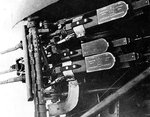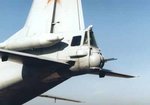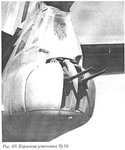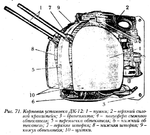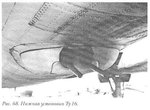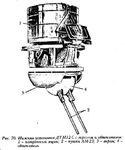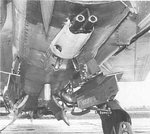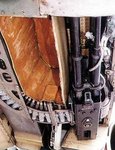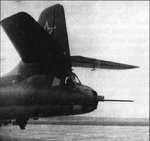- Thread starter
- #81
CharlesBronson
Senior Master Sergeant
From the excellent Tony Williams website.
Grabin Aircraft Guns
© Denis Evstafyev, edited by Anthony G Williams
This article describes some interesting Soviet experiments with large-calibre aircraft guns between 1943 and 1950
Vasily Gavrilovich Grabin (1899-1980) attended the Petrograd artillery school, fnishing in 1923, and in 1930 joined the Military Technical Academy of General-Colonel F.E.Dzerzhinskog, Dr.Sci.Tech. In 1934 he became the head of the Design Bureau of Artillery Systems.
At the beginning of July 1943 the GKO (Gosudarstvennii Komitet Oboroni - State Defence Committee) decided that a 45 mm automatic gun should be developed for arming fighters. V.G.Grabin had never previously been involved with aviation guns, but on this occasion decided to compete with the established experts. The Design Bureau "Central Artillery" agreed, and Grabin worked with the TsceAKB (Central Artillery Design Bureau) in developing all types of artillery systems, including aviation and naval.
In 1943-1944 the TsceAKB produced designs for two large-caliber aviation automatic guns: the 57 mm S-10 and 45 mm S-20. These guns had an almost identical construction, the basic difference being the calibre. The automatic mechanism was recoil-operated and belt-fed. Both guns were located in a uniform cradle with a weight of 45.5 kg which was rigidly fastened to the fuselage.
Experimental models of the S-10 and S-20 guns were made and tested. The average rate of fire of the S-20 was 140 rounds per minute. Neither gun made it into service and in 1946 work on them was stopped.
An experimental 45 mm gun designed by OKB-15 was tested in a LaGG-3 fighter, but without success.
In the early post-war years the Air Force command considered it necessary to equip the fighters of Air Defence (PVO) with powerful aviation guns of 45 mm calibre and larger. The basic purpose of these large-calibre guns was to combat the American heavy bombers, but such guns could also be used to attack tanks.
In 1946 TsceNII-58 entered into a competition with OKB-16, having designed three guns under the system designation V14, in calibres 76 mm (V14-111), 57 mm (V14-112) and 37-mm (V14-113). The 37 mm V14-113 was intended for turret installations on bombers. The 57 mm V14-112 and 76 mm V14-111 were intended for fixed installations on fighters, bombers and attack planes.
All of the operations of the 37 mm V14-113 were powered by a short-recoil action. The weight of the moving parts was 37 kg. A contract for the design of the V14-113 was signed on June, 29, 1946. By 1949 three experimental V14-113 guns had been made and their production tests started. Only one type of shell was used – a high-explosive incendiary tracer (OFZT), made by TsceNII-58. During ground tests the 37 mm OFZT shell showed good results. At a distance of 600 m the vertical dispersion was 0.17 m, and the lateral 0.16 m. The shell traced to 1100 m. The conclusion of the commission testing the 37 mm shell OFZT was that one hit on a Pe-2 bomber would be guaranteed put it out of action.
The 57 mm A14-112 was also a short-recoil design. The gun had a heavy bolt, connected to a hydraulic recoil cylinder. Like the 37 mm gun, it had a belt feed with pneumatic reloading and had no muzzle brake. By 1949 one example of the V14-112 was made and tested. As with the 37 mm, only one type of shell was made by TsceNII-58 for V14-112; the high-explosive incendiary tracer. By December 1948 an experimental batch of 57-mm OFZT shells had passed its ground tests.
The V14 guns were not accepted for Air Force service. In 1947-1948 the TsceNII-58 (the former TsceAKB) developed two even more powerful aviation guns: the 57 mm V-7031 and the 65 mm 0904.
The 57 mm V-7031 was much more powerful than the previously mentioned V14-112. In the V14-112, the two-kilogram shell had a muzzle velocity of 555 m/s, but the new gun fired a 2.93 kg shell at 965 m/s. The ballistics of the V-7031 were therefore close to those of the ZIS-2 57 mm anti-tank gun.
The operating mechanism of the V-7031 used the short-recoil principle, and the ammunition feed used a disintegrating belt, with a pneumatic reloading system.
The gun had a muzzle brake which absorbed up to 55 percent of the recoil energy. The TsceNII-58 made two shells for the 57 mm V-7031: OFZT and BRZT (armour-piercing incendiary tracer). Some 2100 rounds were fired in the tests of two experimental V-7031 guns up to 1948. In 1949 the third example of the gun passed its control tests in the scientific research institute of the Air Force.
Works on the automatic aviation 65 mm 0904 gun started in 1947. The operating system remained short-recoil, with a disintegrating belt feed and pneumatic reloading. The gun had a muzzle brake absorbing up to 46 % of the recoil energy. The 0904 gun represented the combination of a 65 mm barrel with the 57 mm V-7031 gun and had 80 percent of the parts in common. Again, both OFZT and BRZT shells were made by TsceNII-58.
In 1948 two experimental 0904 models were made and passed their production tests. In 1949 one sample was sent for field tests to the scientific research institute of the Air Force in Ahtubinsk. During tests of the 65 mm shells OFZT and BRZT it was determined that they completely satisfied the requirements of the Air Force. The OFZT showed vertical and lateral dispersion of about 0.2 m and 0.22 m respectively at a distance of 600 m, and the tracers functioned for 6 seconds. The HE shell penetrated 20 mm of armour, but modification of the fuze raised this to 25 mm.
The accuracy of the 65 mm BRZT shell appeared even better: 0.16 and 0.19 m respectively. At a distance of 600 m the shell penetrated 60 mm of armour plate at a striking angle of 30 degrees. This shell could therefore penetrate from above the armour of any tank of that time.
Neither the V-7031 and 0904 were accepted for service. In the new era of subsonic and supersonic jet planes, such powerful guns were not felt to be necessary.
In 1948 in the TsceNII-58 works, the design of the 100 mm aviation automatic gun V-0902 was begun. It was supposed to arm bombers like the Tu-2 and Tu-4: naturally, any small fighter, whether piston-engined (Yak-3, La-5, La-7, La-9, etc.) or a jet (Yak-15, MiG - 9, etc.), could not physically carry this gun because of its weight and recoil.
The 100 mm V-0902 gun utilised a long-recoil mechanism and had a 15-round magazine. It was equipped with a very effective muzzle brake which absorbed up to 65 percent of the recoil energy. It was designed to be particularly compact. The weight of a gun without its ammo box was 1,350 kg, the rate of fire 30.5 rounds per minute. The recoil force was 5 tons. The firing and reloading controls were in the pilot's cockpit.
In 1948 an experimental V-0902 was made and production tests carried out. In 1949 bench tests and debugging firings were carried out and the gun was modified accordingly. The sample was prepared for flight tests at the end of the year, but no trace of any documents concerning flight tests has been found.
TsceNII-58 developed three shells for the V-0902: FZT, BRZT and one carrying sub-projectiles.
The FZT round weighed 27 kg and was 990 mm long. The propellant charge weighed 4.47 kg and provided a muzzle velocity of 810 m/s, with a maximum chamber pressure of 2850 kg/sm2. Tests showed that it was effective out to a range of 1000-1200 m.
The BRZT round had a weight of 27.34 kg and length of 956 mm. The propellant charge weighed 4.55 kg, and the muzzle velocity was 800 m/s. The shell used an MD-8 fuze, and the tracer burned for 5 seconds. During tests this shell penetrated 120 mm of armour at a 30° striking angle, at a distance of 600 m.
For shooting at air targets it a shell containing sub-projectiles was developed. The shell weighed 15.6 kg and contained 0.605 kg of an explosive (a burster charge) and 93 high-explosive-incendiary sub-projectiles weighing between 52 and 61 grams. The shell was equipped with a VM-30 time fuze. In 1948-1949 experimental batches of these shells with both unitary and ring arrangements of the high-explosive-incendiary elements were tested. The effectiveness of the action of the shell and the ability of the sub-projectiles to ignite aircraft were tested by shooting at aircraft on the ground.
The 100 mm V-0902 gun became the most powerful automatic aircraft weapon, not only in the USSR, but also, apparently, in the world. From the technical point of view it was a masterpiece of engineering. The problem was that it was five years too late. In 1944-1945 a high-speed heavy piston-engined fighter with the V-0902 could have safely engaged close formations of B-17 and B-29 bombers from a distance of 1 km or more. But the appearance of jet fighters cardinally changed the tactics of the air battle, and heavy air guns lost their value.
According to some sources, the development of the 57, 65 and 100 mm aviation guns was influenced by espionage information that powerful large-calibre automatic aviation guns were being developed in the USA. It was later discovered that this was disinformation
Grabin Aircraft Guns
Grabin Aircraft Guns
© Denis Evstafyev, edited by Anthony G Williams
This article describes some interesting Soviet experiments with large-calibre aircraft guns between 1943 and 1950
Vasily Gavrilovich Grabin (1899-1980) attended the Petrograd artillery school, fnishing in 1923, and in 1930 joined the Military Technical Academy of General-Colonel F.E.Dzerzhinskog, Dr.Sci.Tech. In 1934 he became the head of the Design Bureau of Artillery Systems.
At the beginning of July 1943 the GKO (Gosudarstvennii Komitet Oboroni - State Defence Committee) decided that a 45 mm automatic gun should be developed for arming fighters. V.G.Grabin had never previously been involved with aviation guns, but on this occasion decided to compete with the established experts. The Design Bureau "Central Artillery" agreed, and Grabin worked with the TsceAKB (Central Artillery Design Bureau) in developing all types of artillery systems, including aviation and naval.
In 1943-1944 the TsceAKB produced designs for two large-caliber aviation automatic guns: the 57 mm S-10 and 45 mm S-20. These guns had an almost identical construction, the basic difference being the calibre. The automatic mechanism was recoil-operated and belt-fed. Both guns were located in a uniform cradle with a weight of 45.5 kg which was rigidly fastened to the fuselage.
Experimental models of the S-10 and S-20 guns were made and tested. The average rate of fire of the S-20 was 140 rounds per minute. Neither gun made it into service and in 1946 work on them was stopped.
An experimental 45 mm gun designed by OKB-15 was tested in a LaGG-3 fighter, but without success.
In the early post-war years the Air Force command considered it necessary to equip the fighters of Air Defence (PVO) with powerful aviation guns of 45 mm calibre and larger. The basic purpose of these large-calibre guns was to combat the American heavy bombers, but such guns could also be used to attack tanks.
In 1946 TsceNII-58 entered into a competition with OKB-16, having designed three guns under the system designation V14, in calibres 76 mm (V14-111), 57 mm (V14-112) and 37-mm (V14-113). The 37 mm V14-113 was intended for turret installations on bombers. The 57 mm V14-112 and 76 mm V14-111 were intended for fixed installations on fighters, bombers and attack planes.
All of the operations of the 37 mm V14-113 were powered by a short-recoil action. The weight of the moving parts was 37 kg. A contract for the design of the V14-113 was signed on June, 29, 1946. By 1949 three experimental V14-113 guns had been made and their production tests started. Only one type of shell was used – a high-explosive incendiary tracer (OFZT), made by TsceNII-58. During ground tests the 37 mm OFZT shell showed good results. At a distance of 600 m the vertical dispersion was 0.17 m, and the lateral 0.16 m. The shell traced to 1100 m. The conclusion of the commission testing the 37 mm shell OFZT was that one hit on a Pe-2 bomber would be guaranteed put it out of action.
The 57 mm A14-112 was also a short-recoil design. The gun had a heavy bolt, connected to a hydraulic recoil cylinder. Like the 37 mm gun, it had a belt feed with pneumatic reloading and had no muzzle brake. By 1949 one example of the V14-112 was made and tested. As with the 37 mm, only one type of shell was made by TsceNII-58 for V14-112; the high-explosive incendiary tracer. By December 1948 an experimental batch of 57-mm OFZT shells had passed its ground tests.
The V14 guns were not accepted for Air Force service. In 1947-1948 the TsceNII-58 (the former TsceAKB) developed two even more powerful aviation guns: the 57 mm V-7031 and the 65 mm 0904.
The 57 mm V-7031 was much more powerful than the previously mentioned V14-112. In the V14-112, the two-kilogram shell had a muzzle velocity of 555 m/s, but the new gun fired a 2.93 kg shell at 965 m/s. The ballistics of the V-7031 were therefore close to those of the ZIS-2 57 mm anti-tank gun.
The operating mechanism of the V-7031 used the short-recoil principle, and the ammunition feed used a disintegrating belt, with a pneumatic reloading system.
The gun had a muzzle brake which absorbed up to 55 percent of the recoil energy. The TsceNII-58 made two shells for the 57 mm V-7031: OFZT and BRZT (armour-piercing incendiary tracer). Some 2100 rounds were fired in the tests of two experimental V-7031 guns up to 1948. In 1949 the third example of the gun passed its control tests in the scientific research institute of the Air Force.
Works on the automatic aviation 65 mm 0904 gun started in 1947. The operating system remained short-recoil, with a disintegrating belt feed and pneumatic reloading. The gun had a muzzle brake absorbing up to 46 % of the recoil energy. The 0904 gun represented the combination of a 65 mm barrel with the 57 mm V-7031 gun and had 80 percent of the parts in common. Again, both OFZT and BRZT shells were made by TsceNII-58.
In 1948 two experimental 0904 models were made and passed their production tests. In 1949 one sample was sent for field tests to the scientific research institute of the Air Force in Ahtubinsk. During tests of the 65 mm shells OFZT and BRZT it was determined that they completely satisfied the requirements of the Air Force. The OFZT showed vertical and lateral dispersion of about 0.2 m and 0.22 m respectively at a distance of 600 m, and the tracers functioned for 6 seconds. The HE shell penetrated 20 mm of armour, but modification of the fuze raised this to 25 mm.
The accuracy of the 65 mm BRZT shell appeared even better: 0.16 and 0.19 m respectively. At a distance of 600 m the shell penetrated 60 mm of armour plate at a striking angle of 30 degrees. This shell could therefore penetrate from above the armour of any tank of that time.
Neither the V-7031 and 0904 were accepted for service. In the new era of subsonic and supersonic jet planes, such powerful guns were not felt to be necessary.
In 1948 in the TsceNII-58 works, the design of the 100 mm aviation automatic gun V-0902 was begun. It was supposed to arm bombers like the Tu-2 and Tu-4: naturally, any small fighter, whether piston-engined (Yak-3, La-5, La-7, La-9, etc.) or a jet (Yak-15, MiG - 9, etc.), could not physically carry this gun because of its weight and recoil.
The 100 mm V-0902 gun utilised a long-recoil mechanism and had a 15-round magazine. It was equipped with a very effective muzzle brake which absorbed up to 65 percent of the recoil energy. It was designed to be particularly compact. The weight of a gun without its ammo box was 1,350 kg, the rate of fire 30.5 rounds per minute. The recoil force was 5 tons. The firing and reloading controls were in the pilot's cockpit.
In 1948 an experimental V-0902 was made and production tests carried out. In 1949 bench tests and debugging firings were carried out and the gun was modified accordingly. The sample was prepared for flight tests at the end of the year, but no trace of any documents concerning flight tests has been found.
TsceNII-58 developed three shells for the V-0902: FZT, BRZT and one carrying sub-projectiles.
The FZT round weighed 27 kg and was 990 mm long. The propellant charge weighed 4.47 kg and provided a muzzle velocity of 810 m/s, with a maximum chamber pressure of 2850 kg/sm2. Tests showed that it was effective out to a range of 1000-1200 m.
The BRZT round had a weight of 27.34 kg and length of 956 mm. The propellant charge weighed 4.55 kg, and the muzzle velocity was 800 m/s. The shell used an MD-8 fuze, and the tracer burned for 5 seconds. During tests this shell penetrated 120 mm of armour at a 30° striking angle, at a distance of 600 m.
For shooting at air targets it a shell containing sub-projectiles was developed. The shell weighed 15.6 kg and contained 0.605 kg of an explosive (a burster charge) and 93 high-explosive-incendiary sub-projectiles weighing between 52 and 61 grams. The shell was equipped with a VM-30 time fuze. In 1948-1949 experimental batches of these shells with both unitary and ring arrangements of the high-explosive-incendiary elements were tested. The effectiveness of the action of the shell and the ability of the sub-projectiles to ignite aircraft were tested by shooting at aircraft on the ground.
The 100 mm V-0902 gun became the most powerful automatic aircraft weapon, not only in the USSR, but also, apparently, in the world. From the technical point of view it was a masterpiece of engineering. The problem was that it was five years too late. In 1944-1945 a high-speed heavy piston-engined fighter with the V-0902 could have safely engaged close formations of B-17 and B-29 bombers from a distance of 1 km or more. But the appearance of jet fighters cardinally changed the tactics of the air battle, and heavy air guns lost their value.
According to some sources, the development of the 57, 65 and 100 mm aviation guns was influenced by espionage information that powerful large-calibre automatic aviation guns were being developed in the USA. It was later discovered that this was disinformation
Grabin Aircraft Guns

